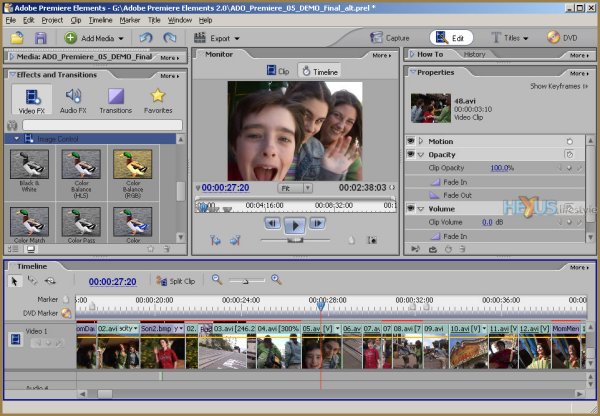Nice and easy does it, says Adobe
Ease of use and greater creativity are the main claimed selling points of the latest version of Adobe's basic video editing program Premiere Elements 2.0 due in October along with V4 of the company's basic stills editor Photoshop Elements.
Each program carries a suggested price of £70 (inc VAT) but the two will be available together in a money-saving bundle for £100. Both are Windows-only, though Adobe says that Photoshop Elements 4.0 (covered in a separate news story) will be available in a Mac version - but without giving any date.
The interface for Premiere Elements 2.0 – which works across two monitors but is expected typically to be used on one – is no less busy than in V1 but far easier to live with and can even have brightness and colour background changed.
Its various windows automatically resize as any one pane is made larger or smaller. Windows in the interface can be undocked, minimised, closed or even added as tabs to other windows. As before, the timeline can have 99 video tracks and 99 audio.
 V2.0's interface is far easier to live with than V1.0's
V2.0's interface is far easier to live with than V1.0's In many instances, though, Adobe has been playing catch-up with the new features added with Premiere Elements 2. On the DVD side, for instance, V2 gains a number of capabilities that have been standard for some while on competing products.
These include support for Dolby stereo and for writing to dual-layer discs, though like competitor programs, Premiere Elements doesn't allow users to choose where layer-breaks happen. Also on the list are full-motion DVD menu buttons and backgrounds, with custom audio; previewing DVD projects using a virtual remote handset; and a fit-to-disc option that changes the encoding rate according to how much footage needs to be recorded to a DVD.
It's a similar catch-up story with the range of supported interconnects and video formats. Version 2 can capture DV via USB from supported camcorders and is able to import VOB files from non-protected DVDs. The program can also bring in video from mobile phones in 3GP, ASF, or MPEG4 formats, and from digital stills cameras in MPEG1, 3GP, ASF, MPEG4, AVI, or MOV.
Videos shot on phones or still cameras are often the wrong way up, so the program offers one-click rotation to bring them the right way round. Irrespective of how video was sourced, finished projects can be output in formats that can be uploaded to suitable phones, cameras and other portable kit including Microsoft Mobile Media Center Playforsure devices.
In contrast with new versions of some other sub-£100 video editors, notably Ulead VideoStudio 9 and the forthcoming Pinnacle Studio 10, Premiere Elements 2.0 does not support HDV – a major omission given the arrival of low-cost HDV camcorders.
Effects and transitions can now be applied with greater confidence – the library shows previews (animated in the case of transitions) to make it easier to choose what to apply.
A new, context-sensitive Properties panel gives advanced control of effects, presets, title screens and DVD menus - including the option for accurate key-framing. The panel is topped by a pair of tabs one giving context-sensitive help, the other an editor history with selectable undos. Time spent customising effects isn't wasted - the panel allows them to be saved for instant recall.
Slide-shows can be created for VCD or DVD and there's greater control of the appearance with enhanced pan-and-zoom controls and the ability to change the duration and transition on individual slides and to fit a slideshow to a particular piece of music or commentary.
A nice touch – projects can be easily backed up or moved from PC to PC using a new archive tool. This has options to save all related media or just the media that's actually been used. Educational buyers are offered very cheap prices on volume purchases and Adobe says the tool will be of particular use in schools and colleges where many different users need to share a limited number of PCs.
Adobe's quoted minimum system requirements for Premiere Elements 2.0
Windows XP Home, Pro, Media Center Edition (with SP2); CPU with SSE2 instruction set (Intel P4, M, D, Extreme Edition or AMD Athlon XP, XP-M,
Opteron, Athlon 64); 256MB RAM; 16-bit graphics card with 1024x768 display; DirectX 9-compatible display and sound drivers; 2GB of available hard disk space for installation; DVD-ROM drive for installation.
Pending our full review of Premiere Elements 2.0, check out Adobe's press release. Also take a look at the reviewer's guide - you'll need an unzipping program, such as WinZip or WinRAR - and have your say in this HEXUS.lifestyle forum.













